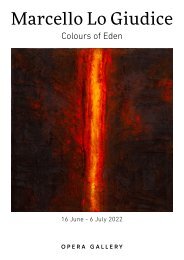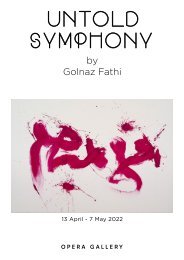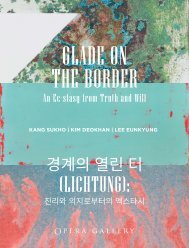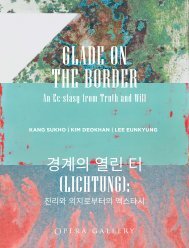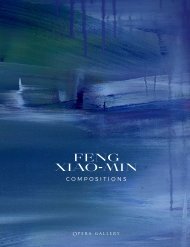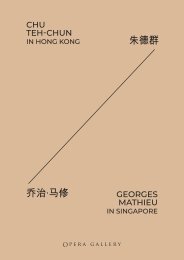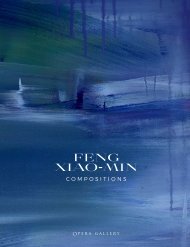Cho Sung-Hee | Paradise Regained | Opera Gallery New York | 10 Nov. - 8 Dec. 2021
You also want an ePaper? Increase the reach of your titles
YUMPU automatically turns print PDFs into web optimized ePapers that Google loves.
CHO SUNG-HEE<br />
<strong>Paradise</strong> <strong>Regained</strong>
CHO SUNG-HEE<br />
<strong>Paradise</strong> <strong>Regained</strong>
2 3
FOREWORD<br />
<strong>Opera</strong> <strong>Gallery</strong> is thrilled to present <strong>Cho</strong> <strong>Sung</strong>-<strong>Hee</strong>’s first solo exhibition in <strong>New</strong> <strong>York</strong> City. The show<br />
features 22 new artworks carefully curated for the occasion.<br />
Born in South Korea, <strong>Cho</strong> <strong>Sung</strong>-<strong>Hee</strong> is a visionary artist exploring the complex relationship between<br />
color and texture through a labour intensive, time-consuming process. She uses a collage method<br />
in which she hand-cuts or tears hanji paper into small circles then glues them onto her surfaces<br />
using a Korean wood glue. She then paints the individual pieces with oil paints, continuing to glue,<br />
paint, and layer, until she is satisfied with the outcome.<br />
For generations artists have experimented with monochromes, investigating its potential and<br />
limitations. <strong>Cho</strong>’s monochromes seem complex in a close proximity, but with enough distance<br />
they become a cohesive monochromatic field. In reducing the artwork to its simplest physical<br />
elements of form, color, and texture, we can view <strong>Cho</strong>’s work as part of Dansaekhwa, which focuses<br />
on repetition, action, and tactile sensation.<br />
Her monochromes and multi-colored works alike seek to achieve pure beauty and harmony.<br />
The painstaking collage process transports the artist back to her intensely joyful childhood, like<br />
a memory of paradise regained. A majority of the works contain the word “blossom” in the title,<br />
a reference to happy memories growing up and playing in her father’s garden.<br />
Artworks by <strong>Cho</strong> <strong>Sung</strong>-<strong>Hee</strong> have been exhibited and collected in various prestigious private and<br />
public institutions around the world including the Museum of Contemporary Art, Seoul; the Sejong<br />
Art Centre, Seoul; the Telentine Art Centre, Chicago; the L.A. Korea Cultural Service, Los Angeles;<br />
the <strong>New</strong> <strong>York</strong> Cultural Service; the Mutual Saving and Finance Company, Seoul and Domino Foods,<br />
Inc, <strong>New</strong> <strong>York</strong>.<br />
We hope you find much beauty and pleasure in this solo show, featuring an artist at the forefront<br />
of Contemporary Korean Art.<br />
Gilles Dyan<br />
Founder and Chairman<br />
<strong>Opera</strong> <strong>Gallery</strong> Group<br />
Laura Adams<br />
Deputy Director<br />
<strong>Opera</strong> <strong>Gallery</strong> <strong>New</strong> <strong>York</strong><br />
5
WILL TO RETURN TO THE<br />
‘LOST PARADISE’<br />
I.<br />
<strong>Cho</strong> <strong>Sung</strong>-<strong>Hee</strong> was raised in a traditional house<br />
surrounded by a beautiful garden. Her father’s<br />
passion was gardening, which sprouted <strong>Cho</strong>’s<br />
love of flowers. In his garden, where multifarious<br />
colored flowers are at abundance, <strong>Cho</strong> may have<br />
dreamt of the ‘Kingdom of Flowers’.<br />
A long time has passed since, and <strong>Cho</strong> now uses<br />
the ‘Kingdom of Flowers’ as a theme for her art.<br />
If the garden in her childhood is a paradise, the<br />
work she makes as a mid 70’s old aged artist is<br />
the ‘<strong>Paradise</strong> <strong>Regained</strong>.’ <strong>Cho</strong> dreams of her lost<br />
paradise. And because she does so, her devoted<br />
series of current works are the long journey in<br />
search of her lost paradise.<br />
If traveling back in time through a time-capsule<br />
was possible, we may find those tight knots<br />
formed throughout our long lives on the way.<br />
Would it be too quick to justify those knots as a<br />
deep sorrow of concentrated secretion of helpless<br />
grieving moments of life? In a traditional society,<br />
where the Patriarchal Confucianism was the<br />
foundation of moral principle, a position of a<br />
female was especially vulnerable. Therefore,<br />
many women, without much emotional refuge,<br />
used work-songs during weaving and sewing to<br />
unwind the suppression and the discrimination.<br />
A form of art such as singing, dancing, painting,<br />
and writing were excellent tools of vicarious<br />
pleasure to escape the suppression.<br />
II.<br />
A thought has struck while looking at these<br />
extremely laborious hanji works. Why would<br />
<strong>Cho</strong> willingly go to such an arduous extent?<br />
The reason for such thought was because this<br />
difficult work process of using only the hand to<br />
make and attach retrogresses the automation<br />
process of modern society. The reality of selling<br />
work depended on manual processes in a cyber<br />
era where NFT and metaBUS are discussed<br />
seems utterly unrealistic.<br />
However, on a deeper thought, the manual<br />
process <strong>Cho</strong> entirely depends on has meaning in<br />
many ways. First, it is her refusal and resistance<br />
to speed and a modern automation system<br />
that prioritizes efficiency and functionality. The<br />
physical, actual, object of art takes on a new<br />
significance in the current artistic climate where<br />
fantastic visual spectacles are built entirely<br />
through the cyber world. How and when can<br />
we judge if a contest between real and virtual is<br />
possible? Is such assumption even appropriate in<br />
the realm of art? Beginning with art, the reason<br />
for such a question is because every human<br />
endeavor depends on legitimacy in action. Both<br />
the art having a foundation in the cyber world and<br />
<strong>Cho</strong>’s work of the manual process of laborious<br />
endeavor has significance and depends on the<br />
legitimacy of action. If so, is coexistence not<br />
inevitable? Of course.<br />
However, what needs to be thought through is the<br />
perspective of lagging behind. I discover answers<br />
to such thoughts in <strong>Cho</strong>’s work. For example, the<br />
message pertaining to the ‘recovery of dream’<br />
in <strong>Cho</strong>’s work is such.<br />
As you know, <strong>Cho</strong> endures through a great amount<br />
of labor to realize her theme of ‘lost garden<br />
(paradise)’ in her art. If she was a gardener,<br />
her dreams would have been made through<br />
landscaping. But as an artist, she is realizing<br />
her dreams through the methods of painting,<br />
sculpture, and installation. This is very important in<br />
the realm of art. Art is not the result but a process;<br />
it is the same as life always being progressive and<br />
art has to be a progression towards completion.<br />
7
III.<br />
It is important to look at <strong>Cho</strong>’s work process here<br />
momentarily. <strong>Cho</strong> makes numerous components<br />
before working full-scale. First, hanji is cut into<br />
numerous sized circles to form petals and<br />
rectangles to be rolled into flower stems. Each<br />
piece is then glued individually by hand. What<br />
follows is the coloring process. Oil pigments<br />
diluted in turpentine are sprayed through a big<br />
brush. Turpentine is a natural resin which absorbs<br />
very well into hanji. She repeats this process<br />
dozens of times.<br />
The result of <strong>Cho</strong>’s tireless and repetitive actions<br />
is beautiful and unique. <strong>Cho</strong>’s monochromatic<br />
and polychromatic flowers are imbued with her<br />
energy. Through her process, she finds her way<br />
back to the idyllic garden of her childhood, and<br />
in so doing, transports the viewer there too. It<br />
has a healing, cathartic effect for both the artist<br />
and the viewer. In regards to such phenomena,<br />
I have written for <strong>Cho</strong>’s solo exhibition of the<br />
past as follows.<br />
“<strong>Cho</strong> <strong>Sung</strong>-<strong>Hee</strong>’s work can be viewed as a<br />
condensation of her existence as well as the<br />
epitome of life itself. It appears as if each of the<br />
small, round hanji sculptures which embroider<br />
her works reflect the artist’s particular character,<br />
as seen in representations of the countless stars<br />
in a night sky; the lotus leaves that fill the surface<br />
of a pond. As like beautiful blossom petals fallen<br />
and stacked by fluttering lightly in the wind or an<br />
overgrown field covered with clovers. When these<br />
approach us as one unified imagery, it is then<br />
when we begin to read the inner thoughts of the<br />
artist. The existence of a single artistic work is to<br />
act as a vehicle of communication between the<br />
artist and the audience. Through this perspective,<br />
we can have an extended conversation with the<br />
artist. And then we would come to ask, what is<br />
the source of the artist’s incredible passion? As<br />
we observe the works which are the products<br />
of the artist’s life, we come to ask this question.<br />
From this perspective and through her work, we<br />
can detect her subtle inner feelings, as well as a<br />
strong will and passion she has toward her art.”<br />
- Yoon Jin Sup, Viewing the Universe of Life: On<br />
<strong>Cho</strong> <strong>Sung</strong>-<strong>Hee</strong>’s Work With Hanji<br />
“Laborious” work becomes a temporary bridge<br />
linking the reality to the ideal. It is a bridge to<br />
the ‘lost paradise’ of the audience’s dream of<br />
the ideal and in turn bears a healing effect to<br />
forget the harshness of reality. They blow passion<br />
into the ones viewing, especially, in the emitting<br />
force of the red and the blue monochromatic<br />
works. Monochromatic works of <strong>Cho</strong>’s hanji works<br />
seem complex in a close proximity, but with<br />
enough distance they have a special condition<br />
of becoming a cohesive monochromatic field.<br />
It is here that we can view <strong>Cho</strong>’s work as<br />
Dansaekhwa (Korean Monochromatism) which<br />
focuses on repetition, action and tactile sensation.<br />
I have written in regard to <strong>Cho</strong>’s Dansaekhwa<br />
as follows.<br />
“The labor intensive hanji series created by <strong>Cho</strong><br />
radiates an aura unique to handmade objects<br />
which are the product of laborious work. The<br />
labor of the artist in creating this type of work<br />
represents the artist’s struggle with oneself<br />
- even a test of perseverance and displays<br />
an artistic characteristic connected to the<br />
accumulation of time or the passing of time<br />
involved in the process. To highlight this point,<br />
we could even call such labor a “performance”<br />
by the artist. At the heart of a new focus and<br />
understanding of Dansaekhwa which has<br />
won recent international acclaim, is a special<br />
characteristic of Korean culture formed by the<br />
mixing of Confucianism, Taoism, and Buddhism.<br />
With the foregoing in mind, it can be said that<br />
focusing and understanding <strong>Cho</strong>’s hanji works<br />
should also now take place with the foregoing<br />
cultural heritage as a term of reference.”<br />
- Yoon Jin Sup, Viewing the Universe of Life: On<br />
<strong>Cho</strong> <strong>Sung</strong>-<strong>Hee</strong>’s Work With Hanji<br />
<strong>Cho</strong>’s use of hanji in her works is an artist’s<br />
privilege of imagination. Childhood memory of<br />
living in a traditional Korean house, hanok, with<br />
doors and walls pasted with hanji is a root of<br />
<strong>Cho</strong>’s aesthetics. Her current works filled with<br />
creative energy has deep association with her<br />
playful childhood of poking holes in the hanji<br />
pasted doors and windows.<br />
In tandem with a prominent historian, Johan<br />
Hizinga, <strong>Cho</strong>’s work is built upon a ‘play theory’<br />
found in her cultural heritage. <strong>Cho</strong> could not<br />
have continued to endure such a long period of<br />
arduous labor without it. Above all, play has to<br />
be fun. Is it not the play’s constant excavation of<br />
‘lost paradise’ that <strong>Cho</strong> constantly investigates<br />
into new works to broaden the boundaries of<br />
art? Despite her age of mid 70s, <strong>Cho</strong> constantly<br />
investigates to discover a stand-alone domain<br />
of Dansaekhwa through her flaming passion to<br />
step forward to this day.<br />
Yoon Jin Sup, Art critic<br />
8 9
<strong>10</strong>
CHO SUNG-HEE IN CONVERSATION<br />
WITH ANTHONY HADEN-GUEST<br />
<strong>Cho</strong> <strong>Sung</strong>-<strong>Hee</strong> made this mesmerizing suite of<br />
works from hanji, a paper fabricated from the<br />
Korean mulberry tree which has been an Asian<br />
art material for at least fifteen hundred years,<br />
which indeed was so prized that it was often paid<br />
as a tribute in ancient times. And, as to <strong>Cho</strong>’s artmaking<br />
process, the word painstaking doesn’t<br />
do it justice. She hand-cuts the hanji paper into<br />
circles the same size, then glues them onto her<br />
chosen surface, almost always canvas, using a<br />
Korean wood glue, a highly flexible substance,<br />
which allows her to manipulate her materials<br />
way beyond a point at which most other glues will<br />
crack. She then paints the individual pieces in oils,<br />
diluted with turpentine, which is compatible with<br />
the other materials she uses, being a derivative<br />
of pine sap. <strong>Cho</strong> glues and paints, glues and<br />
paints, until the surface has become a presence,<br />
a near bas-relief of layered petals and stems.<br />
She may use tens of thousands of circles to<br />
make a single work, returning to it, repainting,<br />
adding and building it up, until it’s where she<br />
wants it to be.<br />
The blossom worlds that grow at <strong>Cho</strong>’s hands,<br />
the monochromes and the polychromatics alike,<br />
have a singular presence, being at once powerful<br />
and delicate, but the arduous, time-consuming,<br />
indeed painful process of their making begs a<br />
timely question. Tech whizzes have invented<br />
ways and means to do just this kind of stuff in<br />
a fraction of the time. Nowadays teenagers have<br />
the necessary chops. Hello, Photoshop! So why<br />
return to the handiwork of times long gone?<br />
Which is where we go to the back story.<br />
<strong>Cho</strong> <strong>Sung</strong>-<strong>Hee</strong> was born in Korea in 1949. Korea,<br />
especially at that period, was a highly patriarchal<br />
culture but she, her parents, her five brothers<br />
and her sister, were a loving and closely knit<br />
family. Her vivid memories include being lifted<br />
by her father when she was perhaps seven in<br />
the garden that he cherished, in which he liked<br />
to be amongst his flowers. “I have very beautiful<br />
memories of that garden,” she says. “I was a<br />
happy child. Everything was beautiful to me”.<br />
Her father was a banker and they lived in a<br />
traditional house, a hanok, which, in the Korean<br />
fashion, was decorated with hanji. But hanji when<br />
merely used as wall covering would be subjected<br />
to wear and tear so would be replaced every two<br />
years. “That’s when I was given a day or two to<br />
play in the house” <strong>Cho</strong> says. And her play-time<br />
would be part of the renovation because her<br />
mother would ask her to cut out the letters which<br />
formed words, like FATHER, MOTHER, ONE, TWO<br />
and THREE, and would use these cut-outs to<br />
organize the family clothes and belongings. She<br />
was also given a room of the right size where<br />
she was encouraged to decorate the walls.<br />
“I would use these cut-out pieces of paper to<br />
make different shapes. I was allowed to stick<br />
them on the walls. I could paint and draw. I was<br />
really able to express myself,” she says. She<br />
knows that the formal foundations of her adult<br />
work – the collage, the color choices – were laid<br />
right there.<br />
That was when she was about six. Which was<br />
when she became sure that art would be her<br />
life. Other formative memories include being<br />
with her father in the garden he treasured, the<br />
garden in which he had lifted her when she was<br />
about seven, and in which he liked to be amongst<br />
the flowers.<br />
In the 70s <strong>Cho</strong> attended Hongik University, where<br />
her teachers included two of Korea’s most<br />
prominent abstractionists, Kwan Nam and Park<br />
Seo-Bo. After her Bachelors, she went to Ewha<br />
Women’s University for her graduate program.<br />
“The education was primarily revolving around<br />
the evolution from the Ecole de Paris to the School<br />
of <strong>New</strong> <strong>York</strong>, from the Cubists to the Abstract<br />
13
Expressionists,” she says. “I was studying the<br />
importance of those transitions in school. Along<br />
with Duchampian ideas. And a lot of Dadaism<br />
as well.”<br />
She was also making her own art. “I was trying to<br />
express something in a very new way,” she said.<br />
“So I was focusing more on papier maché, using<br />
newspapers. I was trying to mix that, morphing it<br />
into different forms.” <strong>Cho</strong> relocated to the United<br />
States in 1978, enrolling first at the School of<br />
the Art Institute of Chicago, then she went to Los<br />
Angeles to attend Otis College of Art and Design<br />
and studied under Woelffer Emerson. She then<br />
moved to <strong>New</strong> <strong>York</strong> and was making her art,<br />
using newspapers and cardboard boxes as art<br />
material, in a studio on 28 th and <strong>10</strong> th Avenue, an<br />
area then morphing into Chelsea, and she was<br />
showing it in galleries and art spaces in <strong>New</strong><br />
<strong>York</strong>, Chicago and Los Angeles. “But I had hit a<br />
wall,” she says. “No matter how hard I tried to<br />
make my objects, my artworks beautiful, there<br />
were always limitations to what I was doing.<br />
I didn’t just want to make big blocks or express<br />
myself simply by making shapes. I knew I needed<br />
to find the right methodology so as to deliver my<br />
idea of pure beauty.”<br />
An element of biography here becomes relevant,<br />
indeed essential. <strong>Cho</strong> had been married and<br />
they had a son, Lee Jung Ho. The marriage had<br />
not gone well though and had ended in divorce.<br />
Furthermore she wasn’t happy with the idea of<br />
bringing up her son in Manhattan. That and family<br />
pressure brought her back to Seoul in 1987. But<br />
divorce was regarded with intense disapproval<br />
in Korea, especially back then, and <strong>Cho</strong> had felt<br />
under a cloud, even with the family she loved.<br />
“She was in her late 30s, early 40s and she had<br />
to fight to justify her position,” says Jung, her<br />
son. “She became a strong woman. And she’s<br />
an awesome mother.”<br />
Fast forward to 20<strong>10</strong>. <strong>Cho</strong> was in her studio one<br />
day, studying a bare canvas. Just an ordinary<br />
moment in an artist’s workday, right? She<br />
reached out, picked up a piece of hanji that was<br />
lying there and stuck it to the canvas, considering<br />
to maybe use it as a dot.<br />
It was not an ordinary moment in an artist’s<br />
workday, this.<br />
<strong>Cho</strong> handling the hanji had been a trigger,<br />
engulfing her in rich memories. Of childhood,<br />
of her father and the garden in which he picked<br />
her up, of her mother, her sister and her brothers.<br />
It was as if a door had sprung open.<br />
“My collage work had begun,” she says, simply.<br />
<strong>Cho</strong>’s rigorous, demanding work is made in a<br />
studio as precisely set up as a surgery. And I’ll<br />
rely on an eye-witness here. Her son. “If a certain<br />
thing in the studio is not symmetrical – like a<br />
table is not fully aligned - she has to fix that<br />
before she starts working,” says Lee Jung Ho.<br />
“She seeks perfect beauty.”<br />
An interesting cultural difference here. Beauty<br />
can be a touchy word amongst artists in the West,<br />
who tend to see it as a by-product of a successful<br />
process. It is <strong>Cho</strong>’s wholehearted goal with her<br />
work. Consider her monochromes. The landscape<br />
of Western monochromes has famous peaks, such<br />
as Kazimir Malevich’s Suprematism paintings of<br />
1918, White on White, the black canvases that Ad<br />
Reinhardt called “the Last Paintings anyone can<br />
make” and Robert Rauschenberg’s three panel<br />
White Painting of 1951, which he intended to look<br />
as unpainterly as possible, as if untouched by<br />
human hand.<br />
These monochromes, most monochromes, are<br />
riffs on Modernism. Not so those of <strong>Cho</strong>. She<br />
describes her felt need to apply tens of thousands<br />
of hanji to a single surface as both a quest for<br />
14
ideal beauty and a need to fill the space, a desire<br />
for “fullness”.<br />
Are there elements of a Korean aesthetic here,<br />
I wondered?<br />
“The fullness is not necessarily Korean,” she said.<br />
“More my personality. I have to create something<br />
that, according to my eye, is perfectly beautiful.<br />
And when it comes to a monochrome, if from<br />
a far distance it feels there is a spot which is<br />
slightly empty or slightly lacking, I need to fill<br />
that space. I must create a single homogenous<br />
feeling.”<br />
And the polychromatic works?<br />
“There I feel a bit more liberated,” she said.<br />
Just why the continuing pull of collage, I asked?<br />
“In modern society we are exposed to so many<br />
media,” she said. “And so many artworks, of the<br />
past, of the present and by younger artists. This<br />
method of collages is nothing new but it’s my<br />
way of delivering something, with my voice. I am<br />
referencing the past, of course. And respecting it.<br />
The three words I use are reference, deference<br />
and difference. I have a message. I have found<br />
things only I can do. This is me, myself.”<br />
A number of artists now are channeling our<br />
difficult, often dark times. What is the <strong>Cho</strong> <strong>Sung</strong>-<br />
<strong>Hee</strong> message?<br />
“That is very simple. I want to deliver a happy<br />
virus to everybody who feels the work. Why is<br />
that? Because while I am working, while I am<br />
actually making it, when I’m finishing a series,<br />
when I am discovering new shapes, a new way<br />
to express myself with colors, I am overwhelmed<br />
with joy. When somebody looks at a work, or<br />
acquires a work, I want that individual to feel<br />
as happy as I was making it, as I am right now.<br />
I want the audience to feel beauty in the presence<br />
of the work.”<br />
17
ARTIST NOTE
I paint to find a way to the root of beauty. It is<br />
understood that there is no greater beauty than<br />
infinite nature. Therefore, I use the flower, as a<br />
symbol, to get closer to that essence. I am in<br />
ecstasy when coloring a white canvas covered<br />
in hanji, enchanted like walking on a road fully<br />
covered in cherry blossom. However, I cannot<br />
fully express the wonder seen in my imagination<br />
while trapped in the limits of the human mind.<br />
Today, I still travel through the world inside my<br />
canvas in search of perfect beauty.
WORKS
White Blossom<br />
<strong>2021</strong><br />
Korean mulberry paper with oil paint on canvas<br />
63.8 x 51.3 in | 162.2 x 130.3 cm<br />
24
Light Red Blossom (left)<br />
<strong>2021</strong><br />
Korean mulberry paper with oil paint on canvas<br />
32 x 25.6 in | 81.2 x 65 cm<br />
Light Red Blossom (right)<br />
<strong>2021</strong><br />
Korean mulberry paper with oil paint on canvas<br />
63.8 x 51.3 in | 162.2 x 130.3 cm<br />
26
Red Garden with White Star<br />
<strong>2021</strong><br />
Korean mulberry paper with oil paint on canvas<br />
48 x 36.2 in | 122 x 92 cm<br />
28
White Garden<br />
<strong>2021</strong><br />
Korean mulberry paper with oil paint on canvas<br />
63.8 x 51.3 in | 162.1 x 130.3 cm<br />
30
Red Blossom<br />
<strong>2021</strong><br />
Korean mulberry paper with oil paint on canvas<br />
63.8 x 51.3 in | 162.2 x 130.3 cm<br />
32
Garden in the Red<br />
<strong>2021</strong><br />
Korean mulberry paper with oil paint on canvas<br />
63.8 x 51.3 in | 162.1 x 130.3 cm<br />
34
Vermillion with Yellow<br />
2019<br />
Korean mulberry paper with oil paint on canvas<br />
51.3 x 38.2 in | 130.3 x 97 cm<br />
36
Winter Garden<br />
<strong>2021</strong><br />
Korean mulberry paper with oil paint on canvas<br />
51.3 x 63.8 in | 130.3 x 162.1 cm<br />
38
Red Blossom with Blue Grey<br />
<strong>2021</strong><br />
Korean mulberry paper with oil paint on canvas<br />
57.3 x 44.1 in | 145.5 x 112.1 cm<br />
40
Blue Gray Garden<br />
<strong>2021</strong><br />
Korean mulberry paper with oil paint on canvas<br />
32 x 25.6 in | 81.2 x 65 cm<br />
42
Blue Blossom<br />
<strong>2021</strong><br />
Korean mulberry paper with oil paint on canvas<br />
63.8 x 51.3 in | 162.2 x 130.3 cm<br />
44
Pure Mind<br />
<strong>2021</strong><br />
Korean mulberry paper and polyester with oil paint on canvas<br />
32 x 25.6 in | 81.2 x 65 cm<br />
46
Light Blue Garden<br />
<strong>2021</strong><br />
Korean mulberry paper and polyester with oil paint on canvas<br />
32 x 25.6 in | 81.2 x 65 cm<br />
48
Garden in the Night<br />
<strong>2021</strong><br />
Korean mulberry paper with oil paint on canvas<br />
51.3 x 63.8 in | 130.3 x 162.1 cm<br />
50
The Moon in the Garden<br />
<strong>2021</strong><br />
Korean mulberry paper and polyester with oil paint on canvas<br />
57.1 x 44.1 in | 145 x 112 cm<br />
52
White Garden<br />
<strong>2021</strong><br />
Korean mulberry paper with oil paint on canvas<br />
32 x 25.6 in | 81.2 x 65 cm<br />
54
Green Garden<br />
<strong>2021</strong><br />
Korean mulberry paper with oil paint on canvas<br />
51.3 x 38.2 in | 130.3 x 97 cm<br />
56
Garden<br />
<strong>2021</strong><br />
Korean mulberry paper with oil paint on canvas<br />
51.3 x 76.3 in | 130.3 x 193.9 cm<br />
58
Green Blossom<br />
<strong>2021</strong><br />
Korean mulberry paper with oil paint on canvas<br />
63.8 x 51.3 in | 162.2 x 130.3 cm<br />
60
Beautiful Garden<br />
<strong>2021</strong><br />
Korean mulberry paper with oil paint on canvas<br />
76.1 x 51.3 in | 193.3 x 130.3 cm<br />
62
Purity<br />
<strong>2021</strong><br />
Korean mulberry paper and polyester with oil paint on canvas<br />
32 x 25.6 in | 81.2 x 65 cm<br />
64
BIOGRAPHY AND BIBLIOGRAPHY
BIOGRAPHY<br />
<strong>Cho</strong> <strong>Sung</strong>-<strong>Hee</strong> was born in 1949 in Korea. She earned a master’s degree in fine arts from the Ewha<br />
Women’s University before relocating to America in 1980 where she studied at the Pratt Institute<br />
of Art in <strong>New</strong> <strong>York</strong> City and at the Art Institute in Chicago.<br />
In constructing the surface of her works, <strong>Cho</strong> uses a collage method in which many circles are<br />
hand-cut or gently torn from traditional hanji paper, then layered with oil pigments and placed one<br />
atop another. <strong>Cho</strong> successfully combines a traditional Korean sensibility with her unique vision<br />
and personal narrative. Her works explore the complex relationship between color and texture<br />
through a labour intensive, time-consuming process.<br />
Her works have been exhibited and collected in various prestigious private and public institutions<br />
including the Museum of Contemporary Art, Seoul; the Sejong Art Centre, Seoul; the Telentine Art<br />
Centre, Chicago; the L.A. Korea Cultural Service, Los Angeles; the <strong>New</strong> <strong>York</strong> Cultural Service; the<br />
Mutual Saving and Finance Company, Seoul and Domino Foods, Inc, <strong>New</strong> <strong>York</strong>.<br />
68 69
CHO SUNG-HEE (B. 1949)<br />
1982-83 Pratt Institute of Art, <strong>New</strong> <strong>York</strong><br />
1980-81 Otis College of Art and Design,<br />
Los Angeles and Parsons Paris<br />
1978 Art Institute of Chicago<br />
1975 M.A., Graduate School of Education,<br />
Ewha Women’s University, South Korea<br />
1972 B.A., College of Fine Arts, Hongik<br />
University<br />
Solo Exhibitions & Fairs<br />
<strong>2021</strong> Hakgojae <strong>Gallery</strong>, Seoul, South Korea<br />
2019 <strong>Opera</strong> <strong>Gallery</strong>, Seoul, South Korea<br />
Fondazione Mudima, Milan, Italy<br />
2018 <strong>Cho</strong> <strong>Sung</strong>-<strong>Hee</strong>, Splendid Stars,<br />
<strong>Opera</strong> <strong>Gallery</strong>, London, UK<br />
2017 Sandy Bennet <strong>Gallery</strong>, <strong>New</strong> Jersey, USA<br />
The Armory Show, Tambaran <strong>Gallery</strong>,<br />
<strong>New</strong> <strong>York</strong>, USA<br />
2016 Asia Week, Tambaran <strong>Gallery</strong>, <strong>New</strong> <strong>York</strong>,<br />
USA<br />
2015 Asia Week, Tambaran <strong>Gallery</strong>, <strong>New</strong> <strong>York</strong>,<br />
USA<br />
Art Taipei, Dado <strong>Gallery</strong>, Taiwan<br />
2014 Tambaran <strong>Gallery</strong>, <strong>New</strong> <strong>York</strong>, USA<br />
Tong-In <strong>Gallery</strong>, Seoul, South Korea<br />
2013 <strong>Gallery</strong> Mark, Seoul, South Korea<br />
Kang Collection, <strong>New</strong> <strong>York</strong>, USA<br />
2012 <strong>Gallery</strong> Art Link, Seoul, South Korea<br />
20<strong>10</strong> Chicago Art Fair, <strong>Cho</strong>sun <strong>Gallery</strong>, Chicago,<br />
USA<br />
Korean Art Show, <strong>Cho</strong>sun <strong>Gallery</strong>,<br />
<strong>New</strong> <strong>York</strong>, USA<br />
2009 <strong>Cho</strong>sun <strong>Gallery</strong>, Seoul, South Korea<br />
1996 National Museum of Contemporary Art,<br />
Seoul, South Korea<br />
1995 Gurun <strong>Gallery</strong>, Chicago, USA<br />
1994 Lloyd Shin <strong>Gallery</strong>, Seoul, South Korea<br />
1993 Lloyd Shin <strong>Gallery</strong>, Chicago, USA<br />
1988 Korea Art <strong>Gallery</strong>, Seoul, South Korea<br />
1985 Park Yeo Sook <strong>Gallery</strong>, Seoul, South Korea<br />
1984 Korean Cultural Center, Sculptures and<br />
Construction, <strong>New</strong> <strong>York</strong>, USA<br />
1983 Korean Cultural Center, Sculptures and<br />
Construction, Los Angeles, USA<br />
1981 Shino <strong>Gallery</strong>, Painting & Printmaking,<br />
Los Angeles, USA<br />
Han Kook <strong>Gallery</strong>, Painting & Printmaking,<br />
<strong>New</strong> <strong>York</strong>, USA<br />
1980 Otis/Parson Art Institute North <strong>Gallery</strong>,<br />
Los Angeles, USA<br />
American Cultural Center, Seoul,<br />
South Korea<br />
1979 Tolentine Art Center, Chicago, USA<br />
1978 <strong>Gallery</strong> Hyundai, Seoul, South Korea<br />
1977 Shinsegae <strong>Gallery</strong>, Seoul, South Korea<br />
1975 <strong>Cho</strong>sun <strong>Gallery</strong>, Seoul, South Korea<br />
1972 3.1 Building, Seoul, South Korea<br />
Group Exhibitions & Fairs<br />
2019 Noir & Soulages, <strong>Opera</strong> <strong>Gallery</strong>, Paris,<br />
France<br />
TEFAF, Tambaran <strong>Gallery</strong>, <strong>New</strong> <strong>York</strong>, USA<br />
Art Miami, <strong>Opera</strong> <strong>Gallery</strong>, Miami, USA<br />
The Monaco Masters Show, <strong>Opera</strong> <strong>Gallery</strong>,<br />
Monaco<br />
CHO <strong>Sung</strong>-<strong>Hee</strong> & LEE Gil Rae: Eternal<br />
Spring, <strong>Opera</strong> <strong>Gallery</strong>, Singapore<br />
Asian Art, <strong>Opera</strong> <strong>Gallery</strong>, <strong>New</strong> <strong>York</strong>, USA<br />
Korean Art, <strong>Opera</strong> <strong>Gallery</strong>, Dubai, UAE<br />
Asia week, Tambaran <strong>Gallery</strong>, <strong>New</strong> <strong>York</strong>,<br />
USA<br />
2018 Korean Contemporary, <strong>Opera</strong> <strong>Gallery</strong>,<br />
Seoul, South Korea<br />
Brilliant Hues: The Power of Red and Gold,<br />
<strong>Opera</strong> <strong>Gallery</strong>, Singapore<br />
The Art of Matter, <strong>New</strong> arts of Asia, Monaco<br />
KIAF, <strong>Opera</strong> <strong>Gallery</strong>, Seoul, South Korea<br />
Asia week, Tambaran <strong>Gallery</strong>, <strong>New</strong> <strong>York</strong>,<br />
USA<br />
Amory Antique Show, Tambaran <strong>Gallery</strong>,<br />
<strong>New</strong> <strong>York</strong>, USA<br />
2017 Be Someone Spring, Tambaran <strong>Gallery</strong>,<br />
<strong>New</strong> <strong>York</strong>, USA<br />
2015 Milano World Expo: Today’s Art of Korea,<br />
Villa Clerici Milano, Milan, Italy<br />
2014 Asia Week, Tambaran <strong>Gallery</strong>, <strong>New</strong> <strong>York</strong>,<br />
USA<br />
2013 Art Show Busan, Bexco, Busan, South<br />
Korea<br />
Hong Kong Contemporary 13, Hong Kong<br />
Asia Week, Kang Collection, <strong>New</strong> <strong>York</strong>,<br />
USA<br />
2012 Yeosu International Art Festival, Yeosu,<br />
South Korea<br />
1995 KIAF, Seoul Arts Center, Seoul, South<br />
Korea<br />
1994 Art Exhibition of Music and Dance, Seoul<br />
Arts Center, Seoul, South Korea<br />
1988 Exhibition of Five Contemporary Artists,<br />
Lloyd Shin <strong>Gallery</strong>, Seoul, South Korea<br />
1984 Korean-American Sensibilities, Everson<br />
Museum of Art, Syracuse, <strong>New</strong> <strong>York</strong>, USA<br />
1983 Korean-American Sensibilities, Korean<br />
Cultural Center, Los Angeles, USA<br />
1982 Korean-American Sensibilities, Korean<br />
Cultural Center, <strong>New</strong> <strong>York</strong>, USA<br />
1979 Chicago Women Artists Exhibition, Three<br />
Art Club, Chicago, USA<br />
1978 Oil Painting Exhibition by Eight Women<br />
Painters, Moon Hwa <strong>Gallery</strong>, Seoul, South<br />
Korea<br />
Dong-A <strong>New</strong>s Times Exhibition of Fine<br />
Arts, Modern Art Museum, Seoul, South<br />
Korea<br />
1975 National Exhibition of Fine Arts, Modern<br />
Art Museum, Seoul, South Korea<br />
1974-78 Women Artists Exhibition, National<br />
Museum of Contemporary Art, Seoul,<br />
South Korea<br />
1974 Independent Exhibition, Modern Art<br />
Museum, Seoul, South Korea<br />
Collections<br />
Museum of Contemporary Art, Seoul,<br />
South Korea<br />
Sejong Art Center, Seoul, South Korea<br />
Tolentine Art Center, Chicago, USA<br />
Three Art Club, Chicago, USA<br />
Los Angeles Korean Cultural Center,<br />
Los Angeles, USA<br />
<strong>New</strong> <strong>York</strong> Korean Cultural Center,<br />
<strong>New</strong> <strong>York</strong>, USA<br />
Busan Metropolitan City Children’s Hall,<br />
Busan, South Korea<br />
Domino Sugar & Co., <strong>New</strong> <strong>York</strong>, USA<br />
Sun Jet Construction Co. Ltd., Taiwan<br />
John Quinn Emanuel LLD, Los Angeles,<br />
USA<br />
Tambaran <strong>Gallery</strong>, <strong>New</strong> <strong>York</strong>, USA<br />
Lee Fixel, East Hampton, USA<br />
70 71
INDEX<br />
pp. 24-25<br />
White Blossom, <strong>2021</strong><br />
63.8 x 51.3 in | 162.2 x 130.3 cm<br />
pp. 26-27<br />
Light Red Blossom, <strong>2021</strong><br />
32 x 25.6 in | 81.2 x 65 cm<br />
pp. 26-27<br />
Light Red Blossom, <strong>2021</strong><br />
63.8 x 51.3 in | 162.2 x 130.3 cm<br />
pp. 28-29<br />
Red Garden with White Star, <strong>2021</strong><br />
48 x 36.2 in | 122 x 92 cm<br />
pp. 48-49<br />
Light Blue Garden, <strong>2021</strong><br />
32 x 25.6 in | 81.2 x 65 cm<br />
pp. 50-51<br />
Garden in the Night, <strong>2021</strong><br />
51.3 x 63.8 in | 130.3 x 162.1 cm<br />
pp. 52-53<br />
The Moon in the Garden, <strong>2021</strong><br />
57.1 x 44.1 in | 145 x 112 cm<br />
pp. 30-31<br />
White Garden, <strong>2021</strong><br />
63.8 x 51.3 in | 162.1 x 130.3 cm<br />
pp. 32-33<br />
Red Blossom, <strong>2021</strong><br />
63.8 x 51.3 in | 162.2 x 130.3 cm<br />
pp. 34-35<br />
Garden in the Red, <strong>2021</strong><br />
63.8 x 51.3 in | 162.1 x 130.3 cm<br />
pp. 54-55<br />
White Garden, <strong>2021</strong><br />
32 x 25.6 in | 81.2 x 65 cm<br />
pp. 56-57<br />
Green Garden, <strong>2021</strong><br />
51.3 x 38.2 in | 130.3 x 97 cm<br />
pp. 58-59<br />
Garden, <strong>2021</strong><br />
51.3 x 76.3 in | 130.3 x 193.9 cm<br />
pp. 36-37<br />
Vermillion with Yellow, 2019<br />
51.3 x 38.2 in | 130.3 x 97 cm<br />
pp. 38-39<br />
Winter Garden, <strong>2021</strong><br />
51.3 x 63.8 in | 130.3 x 162.1 cm<br />
pp. 40-41<br />
Red Blossom with Blue Grey, <strong>2021</strong><br />
57.3 x 44.1 in | 145.5 x 112.1 cm<br />
pp. 60-61<br />
Green Blossom, <strong>2021</strong><br />
63.8 x 51.3 in | 162.2 x 130.3 cm<br />
pp. 62-63<br />
Beautiful Garden, <strong>2021</strong><br />
76.1 x 51.3 in | 193.3 x 130.3 cm<br />
pp. 64-65<br />
Purity, <strong>2021</strong><br />
32 x 25.6 in | 81.2 x 65 cm<br />
pp. 42-43<br />
Blue Gray Garden, <strong>2021</strong><br />
32 x 25.6 in | 81.2 x 65 cm<br />
pp. 44-45<br />
Blue Blossom, <strong>2021</strong><br />
63.8 x 51.3 in | 162.2 x 130.3 cm<br />
pp. 46-47<br />
Pure Mind, <strong>2021</strong><br />
32 x 25.6 in | 81.2 x 65 cm<br />
72 73
Titre, Informations<br />
75
Published by <strong>Opera</strong> <strong>Gallery</strong>.<br />
All rights reserved. Except for the purposes of review, no part of this book may be reproduced,<br />
stored in a retrieval system, or transmitted, in any form or by any means, electronic, mechanical,<br />
photocopying, recording or otherwise, without the prior permission of the publishers.<br />
COORDINATORS<br />
Laura Adams, Aurélie Heuzard, Albane Jerphanion<br />
AUTHORS<br />
Anthony Haden-Guest, Yoon Jin Sup<br />
PROOFREADERS<br />
Nadine El Guiddawy, Aurélie Heuzard, Léa Sitbon<br />
DESIGNER<br />
Albane Jerphanion<br />
PRINTER<br />
Relais Graphique<br />
791 Madison Avenue, <strong>New</strong> <strong>York</strong>, NY <strong>10</strong>065 operagallery.com<br />
<strong>New</strong> <strong>York</strong> Miami Bal Harbour Aspen London Paris Monaco Geneva Dubai Beirut Hong Kong Singapore Seoul






